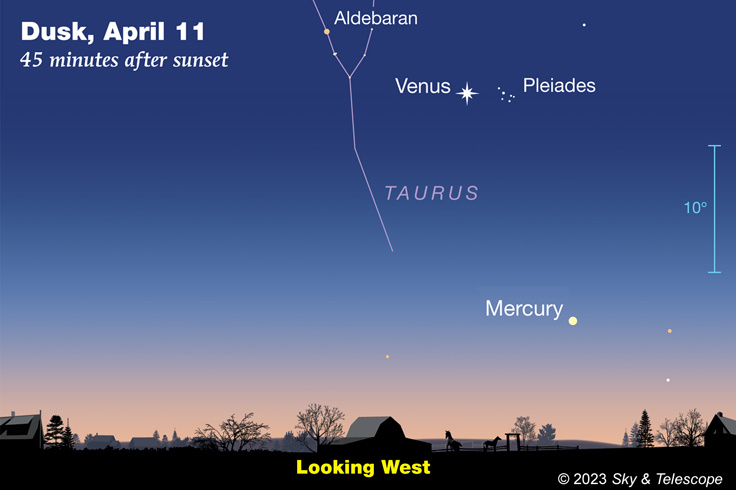This month’s episode offers an easy-to-follow guide to finding the solar system’s two innermost planets after sunset. And then it takes you on a guided tour of the rest of the key stars and planets that you’ll see on April evenings — a fun and informative way to introduce yourself to the nighttime sky!

Listen Here:
Podcast: Play in new window | Download
Subscribe: Apple Podcasts | Google Podcasts | Spotify | Email | RSS | More
In this month’s episode of our long-running Sky Tour astronomy podcast, we follow the Moon around the sky; spot Venus and Mercury soon after sunset; track down a hunter, a lion, a bear, a snake, and a crow; and watch for a modest meteor shower toward month’s end.
The month begins with the Moon waxing toward full, which occurs on the night of April 5th — or the morning of the 6th for those in the Eastern Hemisphere. New Moon follows early on April 20th. You can’t see this phase because the Moon is positioned too closely to the Sun. But if you could somehow, this month they’d appear less than ½° apart! In fact, as seen from Australia and Indonesia, they’ll be precisely on top of each other, briefly causing a total solar eclipse! And so Australia is where I’ll be on the 20th, watching the eclipse with a group of 130 adventurous travelers on a Sky & Telescope tour. A year from now, on April 8, 2024, another total solar eclipse will occur — but this time the Moon’s shadow will cross Mexico, the United States, and northeastern Canada.
As April opens, you’ll have the chance to see not one but both of the planets that circle the Sun inside Earth’s orbit. Make sure your view toward west doesn’t have trees or buildings to block the view. Look west after the Sun has set, and you’ll easily find dazzling Venus well above the horizon.

Sky & Telescope
Starting in the second week of April, look below Venus and a bit to the right, down closer to the horizon. As twilight deepens, a rather obvious star will become apparent. That’s Mercury, which is making its best showing of the entire year this month. It gets easier to see as twilight deepens. But this speedy little planet will start to plunge beginning around April 18th, so catch it while you can.
High up and almost overhead around 9 o’clock is the distinctive constellation Leo, the Lion. He’s facing to the right, with his head and mane forming a big backward question mark that’s a little bigger than your clenched fist. At the bottom of that pattern is Leo’s brightest star, Regulus, meaning “little king.” You can also imagine these stars as a giant sickle, the sharp, long-bladed hand tool that farmers once used to harvest grain.
Trailing behind Leo, farther east, are two bright stars. To the lion’s left is very obvious Arcturus, and to its lower left is Spica, which represents the hand of the constellation Virgo, the Maiden. About four fists below Leo, to the right of Spica, is a box of four medium-bright stars that look something like a misshapen kite. Once you spot it, you’ll recognize it all the time. But do you know which constellation this represents? To find out, check out this month’s Sky Tour episode!
In fact, this monthly podcast is a fun and informative way to introduce yourself to the nighttime sky, no matter what your level of experience. So if you love looking up into a star-filled night sky, download or stream this month’s 12-minute Sky Tour of the stars and planets you can view this month.
 0
0
Comments
You must be logged in to post a comment.